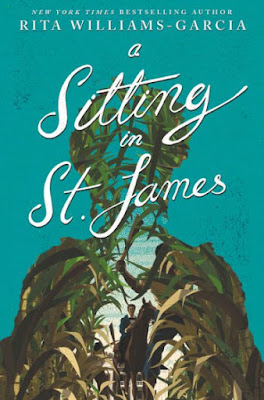Rita William-Garcia begins her epic story by giving a brief history of the land and people in what would later become the boot of Louisiana as a way to usher readers into the main part of her story, and ultimately situate them in the summer of 1860 in St. James parish on the ironically named Le Petit Cottage, home of the Guibert family and the people they enslaved.
The family is headed by its French-born matriarch Madame Sylvie Bernardin de Maret Dacier Guilbert, who never tires of telling people about her connection to Queen Marie Antoinette and the Bernardin de Maret vineyard owned by her family. Madame Sylvie taken from France by a middle age man who forced her to marry him at the age of 13. And before you go feeling sorry for her, know this - Madame Sylvie is so enamored of Marie Antoinette, she named her personal servant, the enslaved Thisbe, a girl taken from her family at age 6 to serve Madame only, after the Queen's dog,
Le Petit Cottage has been run by Madame Sylvie's son, the poetry loving, syphilitic Lucien while her grandson, Bryon, 20, is attending West Point. The plantation is losing money and could soon be in the hands of creditors as Lucien waits for his mother to give him the stash of gold she had buried long ago and which she holds over his head. Bryon is engaged to be married, but he prefers the company of men, specifically his fellow cadet Robinson Pearce. Lucien is also hoping to make a good (and profitable) marriage for his daughter Rosalie, his beautiful, educated "quadroon" daughter. Her mother is an enslaved woman that Lucien raped during one of his visits to the slave quarters where he would often go for that purpose.
After learning that Lucille Pierpont "had her portrait painted and hosted a much-talked-about showing at the Pierpont plantation," Madame Sylvie, now 80, has decided this is something she must also have done, even though the Guilberts can't afford it. And after finding out that a portrait of Bryon's finance's father had been commissioned as a gift to his daughter, Madame is even more determined, and almost beside herself when she learns that the painter was Claude le Brun, a descendant of Madame Elisabeth Louise Vigée Le Brun who had painted a portrait of Sylvie and the daughter of Louis XVI and Marie Antoinette when they were children.
Into this cast of the major white characters comes Eugénie Duhon, Bryon's fiancee, and Jane Chatham, the 15-year-old abandoned daughter of plantation owners who only wants to ride her warhorse, Virginia Wilder, and of course, Bryon's lover Robinson, visiting for a few weeks before they return to West Point.
I kept asking myself why would Rita Williams-Garcia write a story set in the antebellum south from the point of view of white characters. After all, that makes it sound almost like you are going to read an updated version of Gone with the Wind, doesn't it? But that couldn't be further from what Williams-Garcia has actually done here. Because it is through this very flawed, very cruel, entitled family that Williams;Garcia has captured the true horror of the institution of slavery. All the while that Williams-Garcia records the ups and downs of the Guilbert family, standing in the background, quiet, invisible, abused to their white owners are the enslaved Blacks, some of whom we do get to know well.
Had Williams-Garcia focused on only one enslaved character, for example Thisbe, readers wouldn't see how they are all treated and abused. By focusing on this family of enslavers, readers will "witness a brutal period in its benign and overt cruelty, to better understand its legacy of privilege and racism" and how it manifested itself on the people this family considered to be nothing more than property.
I won't kid you - this is not an easy book to read, and yet one that I found hard to put down. There are moments in it when you will pump your arm and say "yes," moments when you will reach for a tissue to wipe away your tears, and moments when you will want to turn away from what you are reading. All I can say is keep reading. This is too important a book to ignore. That said, you may be surprised to discover who the real hero of this story is. And then you will think about it, and you won't be surprised at all.
This book is recommended for readers age 16+
This book was very gratefully received from Keely Platt at Sparkpoint Studio



































No comments:
Post a Comment